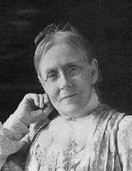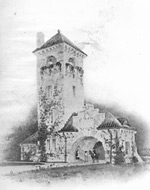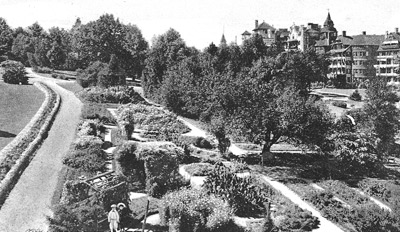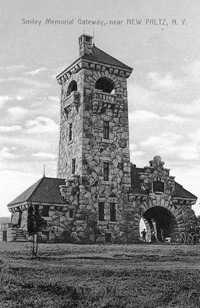The Testimonial GateWay
Summer 2010

ERECTED BY THEIR GUESTS
TO COMMEMORATE THE FIFTIETH ANNIVERSARY
OF THE WEDDING OF
ALBERT KEITH SMILEY AND ELIZA PHELPS SMILEY
THE FOUNDERS OF MOHONK
1857 — JULY 8 — 1907
QUARE MONUMENTUM, CIRCUMSPICE!
Inscription proposed for the arch over the gateway.
Located just 1.3 miles west of the New Paltz village on 299, the Testimonial Gateway has delighted residents and puzzled visitors since its completion in October 1908. Honoring the 50th Wedding Anniversary of Albert and Eliza Smiley, founders of Mohonk Mountain House, the gateway was built from the contributions of 1200 friends of the couple. The images of the Smileys’ are from a commemorative booklet printed for the occasion and given to contributors who could not attend the ground breaking. The book contains all the speeches made that day.
Booklet and postcard are from the Vivian Yess Wadlin collection.
“Words utterly fail me to express to you, my dear friends, my deep appreciation for the magnificent gift to my wife and self on this our golden wedding day, of a very large sum of money to be used in building a commemorative gateway. What a chaste and artistic design you have selected–the finest of its kind I have ever seen! Its lofty tower and massive gateway are supremely attractive. It is to be built of Shawangunk grit, one of the hardest stones in existence, firmly cemented together and fitted to endure the storms of innumerable ages.”
 Those words began Albert Keith Smiley’s response to the gathered friends who had just presented Albert and his wife of fifty years, Eliza Phelps Smiley, with the proceeds that had been donated by more than 1200 individuals for the construction of a “suitable” entrance to the Mohonk property at it eastern end.
Those words began Albert Keith Smiley’s response to the gathered friends who had just presented Albert and his wife of fifty years, Eliza Phelps Smiley, with the proceeds that had been donated by more than 1200 individuals for the construction of a “suitable” entrance to the Mohonk property at it eastern end.  According to Judge Perkins, treasurer for the gift, “subscriptions were fixed at ten dollars because the committee knew that many would want to give who could not well give more and because they wanted the giving to be as popular as the cause.” Judge Perkins continued in his remarks by contrasting the progress the nation had made in the fifty years of the Smiley marriage. Railroads had grown from… “a few thousand miles; now they are measured in the hundreds of thousands miles.” His comments on the changes fifty years had brought cover almost as much territory as the expansion of America itself. California was acquired. The Mexican war fought. The Civil War loser and winner buried their sons.
According to Judge Perkins, treasurer for the gift, “subscriptions were fixed at ten dollars because the committee knew that many would want to give who could not well give more and because they wanted the giving to be as popular as the cause.” Judge Perkins continued in his remarks by contrasting the progress the nation had made in the fifty years of the Smiley marriage. Railroads had grown from… “a few thousand miles; now they are measured in the hundreds of thousands miles.” His comments on the changes fifty years had brought cover almost as much territory as the expansion of America itself. California was acquired. The Mexican war fought. The Civil War loser and winner buried their sons.
One comment in Perkins’ speech is ironic. He mentions the pacifism of the Quaker Smileys, but goes on to comment on the beauty and peace of their other large private estate in California, Clayton Crest Park, located in an America state born of war.
“Clayton Crest Park on the Pacific Ocean and Mohonk on the Atlantic Ocean are examples, separated by a continent, of the achievements of artistic talent and indomitable perseverance.”
For the explanation of how this irony came to pass Perkins continues, “How soon does the spirit of our people amalgamate and how amiable are the adjustments of time.”
The guests had gathered earlier that day at the site of the building to be erected in the Smileys’ honor, to cut the sod, “…. and do as much or as little in the preparation of the ground as their unaccustomed muscles will permit,” stated John Crosby Brown on behalf of the committee as they gathered at the site chosen for the monument. After their labors, the party retired back up the hill to the Mohonk Mountain House parlor for Quaker refreshment (no alcohol) and speeches.
One write-up of the occasion was in a “… leading Trenton paper” as follows:
“Mr. Smiley in his fatherly response opened the book of his historic life in a most frank and delightful manner, calling forth enthusiastic applause.”
 Fortunately for us in 2010, Mr. Smiley’s talk is complete in the Commemorative booklet later produced by the committee. The booklet was given to contributors unable to attend the gala event.
Fortunately for us in 2010, Mr. Smiley’s talk is complete in the Commemorative booklet later produced by the committee. The booklet was given to contributors unable to attend the gala event.
Albert thanked the committee and all the friends who had contributed, with special mention of neighbors Mary and John Arbuckle (of Arbuckle Coffee fame and wealth) whose estate was now partially divided by the sale of 30 acres to the Smileys. (Since that sale is singled out in Albert’s narrative of thanks, I suspect the land was sold to accommodate the road that would lead from the soon to be erected Gateway to the Mountain House, if not the very land on which the gateway arch was to be constructed).
Albert goes on in his address to describe “four red-letter days” in his 80 years, beginning when he and his twin brother, Alfred, were counseled by the principal of the academy they attended near the Kennebec River in Maine. The principal suggested the brothers continue their educations and study Latin (imagine any 2010 student saying the following).
“This suggestion set us on fire and the next day we started Latin. We had to leave the academy in a week or two to chop a year’s supply of wood, and whilst chopping we went through the declensions and conjugations and read a Latin reader through. That fifteen minutes’ talk took us from the farm, sent us on through college and made me an educator for thirty years; four years as an instructor at Haverford college; four years at an an English and Classical academy which my brother and I started in Philadelphia to fit boys for college; two years at the head of a large boarding school established close to my old home, and nineteen years a principal and superintendent of a semi-collegiate school at Providence.”
Albert and Alfred were inseparable, and as identical twins, indistinguishable for the first 27 years of their lives. Albert’s description of what that meant in terms of clothing, childhood illnesses, school work, family life is priceless. He tells the reader, ” Until we were twenty-seven years old, when my brother married, we had never had anything to be called mine, but always ours.”
The next red-letter day Albert describes is meeting a Miss Cornell in August of 1856. “I asked permission to correspond and received a favorable answer.”
Of his subsequent marriage to Miss Cornell, Albert continued,
“I count this the most important and happiest event of my life. We have spent fifty years of uninterrupted and most happy companionship. My dear wife made me promise not to praise her in my response and perhaps she was right, for if I should let my heart loose and tell all the sweetness and unfailing kindness which I have received, I should break down with emotion.”

Postcard image: Alfred Smiley Memorial at Skytop
September 1869 marked Albert’s third red-letter day. Brother Alfred had written to him describing 300 acres of property at Mohonk for sale for $40,000. Albert met Alfred in Poughkeepsie and together they examined Sky Top, Eagle Cliff and the lake. A fire six years earlier had left downed black trees everywhere. In spite of that Albert says, “I fell in love with the scenery and felt sure of its development.” The brothers took an option on the property for the asking price, ” … with some prospect of a reduction.”
Albert left Alfred to consummate the transaction and soon received confirmation that they owned the property and the price was indeed reduced to $27,000. Albert explained that he and his wife had been frugal and had managed to save $14,000. They borrowed the rest to buy the land.
“I bought Mohonk with the idea of making it a home, expecting the hotel to be conducted by an agent, planning to live a mile or more from the hotel and devote my time to developing and beautifying the property.”

Postcard image: Skytop and Lake Mohonk taken from Eagle Cliff.
From the collection of Vivian Yess Wadlin
As it turned out, Alfred ran the hotel for ten years, and Albert continued to work in Providence to pay off the debt and finance the growth of the Mohonk operation. In 1879 Alfred built Cliff House at Lake Minnewaska (he built the the second large hotel, Wildmere in 1887) and left Mohonk to run it, Albert left Providence and returned to run the hotel at Mohonk.

Alfred Smiley, twin brother of Albert, built his hotel, Cliff House, at Lake Minnewasaka. It opened in 1887. His first hotel, Wildmere, opened there in 1879. Alfred had worked with Albert in developing and running the Mohonk Mountain House. Today, the site of Alfred’s hotels is the Minnewaska State Park. For more on these hotels, see Sam Lewit’s story from Summer 2009.
Another Smiley brother, Daniel, who was serving as chief assistant in the Penn Charter School in Philadelphia joined Albert in 1881. Daniel was 27 years younger than his twin brothers. Albert describes him as more like a son than a brother, “My wife and I, having lost our only child forty-five years since, have half adopted him and his wife, their three sons and daughter seem like our grandchildren.”
Seventy-six additional land purchases provided Mohonk with seven square miles of land. “We are continually practicing forestry and from our four square miles of forest we annually cut more than a thousand cords for the benefit of the woods.” A cord of wood is a stack 4′ x 4′ x 8′ or 128 cubic feet.
Albert spoke that day of the 50 miles of roads already constructed on the property, and the plan to build a new road from the “…new gateway to the hotel, following for more than a mile the course of a charming brook.”
Albert thanks many individuals and groups, but especially the guests and the people who worked at Mohonk.
“Whatever success has been attained in the management of the estate has been due largely to the faithful and efficient service given by heads of departments as well as by the great body of our employees who mainly belong to the superior families of Dutch and Huguenot descent living in the neighborhood of the hotel.”
Albert spoke of the intense love he and his family have for the land and his belief that the children and grand children of his brothers would continue to manage and care for the resort. It was important to him for other reasons that the family continue residing at Mohonk.
The health-promoting atmosphere and environment on the mountain was cited, too. According to Albert’s text, when their only child died, the doctors,“…declared she (Eliza Smiley) could not live three months. A little later, I, too, suffered as severe a case of nervous prostration as I have ever known as a result of overwork at the Providence school. We both consider that Mohonk air and outdoor life has brought us through many years in a very fair degree of good health.”
And, of course, the fourth red-letter day for Albert Smiley was the acceptance on his own and Eliza’s behalf of the Testimonial Gateway Arch from his friends and family, celebrating not only the 50th wedding anniversary of the Smileys’ but as token of appreciation for what Mohonk has meant to all.

In a number of the speeches delivered on July 7th in honor of the Smiley’s, 50th wedding anniversary in 1907, the speakers mention the couple’s devotion to the land, its flora and fauna. Today’s “keepers of the Mohonk flame,” owners, landscapers, foresters, and gardeners, are no less devoted. This postcard image, posted July 27, 1907, looks much like Mohonk’s gardens today.
Image from the collection of Vivian Yess Wadlin
“Rest assured that the exquisitely artistic gateway which we owe to your generosity, will have a fitting setting of the choicest trees, shrubs, lawn and rocks–as fine as my brother and I can make. I trust that many generations of men will pass through that portal and climb the mountain through fine scenery, over well built roadways and find on the height not only a well ordered hostelry, but more–a home where warmest greetings will be extended and friendships cultivated; still more than eminent men shall meet here to discuss great national and international questions that pertain to the betterment of the world; and above all that the Omnipotent Creator and Ruler of the Universe, whose tender compassion notices a sparrow’s fall, may be fit honored and reverenced by both hosts and guests till the solid stone gateway shall crumble into dust.”

Lake Mohonk gathering, unidentified group, August 1917, in front of the Testimonial Gateway.
Original photo from the collection of Vivian Yess Wadlin
* * *
Please remember, the Testimonial Gateway is private property. I know you will respect that and view this magnificat structure from public roads only.
Information for this article is from one of the original booklets printed for the event:
1857-1907
The Golden Day
July Eight
 In the early 1970s my mother had a friend who lived in the tower. I recall visiting there with her, but now all that remains is the dull recollection that it was a damp place and that romantic as it seemed at first, I really was glad I did not live there.
In the early 1970s my mother had a friend who lived in the tower. I recall visiting there with her, but now all that remains is the dull recollection that it was a damp place and that romantic as it seemed at first, I really was glad I did not live there.
This postcard, postmarked High Falls and dated January 12, 6am, 1912 was sent to Mrs William Pine, Kyserike, New York with the message: “Dear friend Mable will drop you a few lines to let you know the Shavings are ready any time come up and make us a visit be glad to have you any time we are all well hope you are the same love and best wishes Mrs Andrew Davis” with not a whit of punctuation, but lovely handwriting.
Note the caption on the post card is Smiley Memorial Gateway, which it is often labeled on postcards. Also, did you catch that the card was postmarked at 6am? There was a time when the “post” was delivered several times a day. Many of the postcards in my collection are sent between residents of the small towns in Ulster County. Sometimes the messages are so funny, or touching, or cryptic, that they are in my collection for the message and not the image. Postcards are the definite precursor to email in the import of the messages.
Vivian Yess Wadlin
